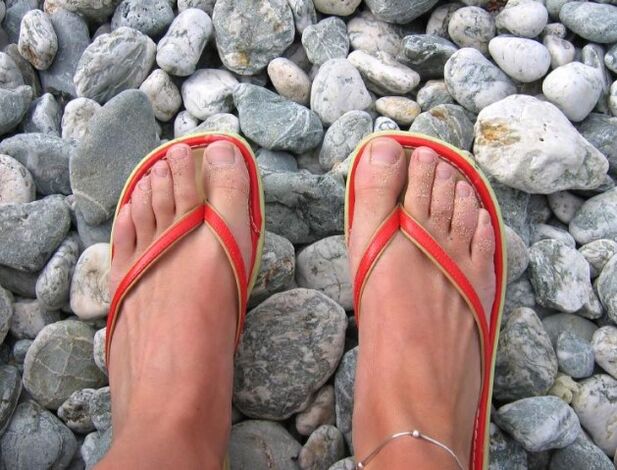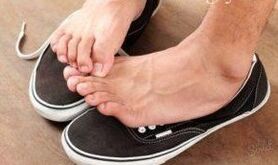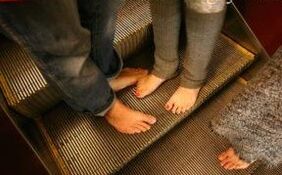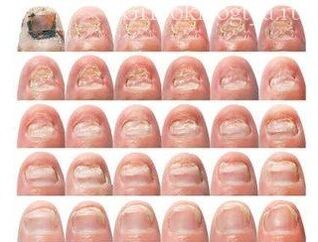

Healthy legs on the legs: standard and deviationTo exclude or identify the presence of fungal diseases, you should examine your own legs, fingers and nails. The following indicators must be maintained:The foot of the legs is smooth, without horns, cors and joints.The skin skin is uniform, without cracks or spots.There is no redness and itching, especially between the fingers. The nail plate is flat, simple, transparent.The nail bed, the surface with the shiny is clearly visible.If there are deviations from declared standards and the legs have an unpleasant spicy smell, a doctor's consultation and an investigation for the presence of the pathogen is necessary.Risk factors for the development of fungi on the legsMushroom infection can occur in absolutely any place, including logs at home. To make it happen enough to have:Low immunity which is unable to restrict the active reproduction of fungi;Increased sweating of the legs, due to poorly selected and poor quality shoes;the presence of cuts in the nail area with an unsuccessful cut of the nail or the cuticle;Insufficient feet hygiene, as well as shoes;Frequent visit to public places in which there is a high risk of infection: city baths, saunas, solarium, swimming pool, local beach;Excessive use of cosmetics (varnish, nails extension, sprays and refreshing legs), which leads to the death of local immunity.The separate types of fungi have a different latent period during which the disease does not manifest. You can be infected with a fungus in two ways:Contact - by direct contact from a sick person to a patient: personal hygiene articles, public places, someone else's shoes.Constantly - The infection occurs due to the active development of fungi found in the body of each person. In certain situations (for example, a sharp decrease in immunity), their number increases and cannot be fully controlled by the body independently.Most often, people in the following categories are subject to fungal lesions:children with a thinner layer of skin;people with HIV infection;with increased perspiration of the feet;The presence of chronic diseases that inhibit the immune system.
If there are the above indicators, the condition of the nails on the legs and stops as a whole is necessary to be carefully monitored, paying particular attention to hygiene.Differentiation of a fungal nail diseaseIn medicine, the concept of "fungal nail damage" is collective, because fungi of various types can act as a pathogen. Most often, such mushrooms are on legs like:Dermatophytes - A group of mushrooms that manifest themselves in the form of yellow spots or white vertical scratches. The infected nail gradually loses its strength and its shape, after which the cavity becomes lifeless and easily withdraws from the bed of the nail.Breast lesions - occur following the active activity of mushrooms of the genus Candida. The nail itself is thinner and the perioline roll blushes and swells. It can manifest itself as an independent disease with frequent colds and weakened immunity.Mussels - are located mainly on the surface of the nail, changing its color into a greenish, brownish or whitish shade.It is impossible to determine the causal agent of a fungal disease yourself, as the same fungi, when exposed to various aggregated factors, can manifest themselves differently. Consequently, it is impossible to start treatment, because each type of fungi has its own antifungal drugs which negatively affect the lives of pathogens. Therefore, when you diagnose the slightest differences in relation to the standard, you must consult a doctor and take a test for the presence of a fungus.Fungal damage steps on the legsThe process of the moment of infection with the complete destruction of the nail plate is called the stages of the course of the disease. Select them 5:Infection - The fungus enters the surface of the nail, plunging through the cuticle in the nail bed. The incubation period (from 3 days to 5 months) - The activity of fungi is minimal, but it intensifies with a lightning speed when all the conditions are created for this: immunity is weakened, there is a hot humid environment, there is no appropriate hygiene. Externally, the incubation period manifests itself in any way.The initial step - The number of mushrooms is so large that it can have a negative effect on the viability of the nail. The edges of the nail baking sheet gradually become yellow from the edge to the nail bed. The nail acquires a matte shade, a healthy pink color disappears, the shiny disappears from the surface. In this case, dry skin of the toes is noted.The active course stadium - the population of mushrooms reaches the maximum, which allows you to infect other nail plates, having received contact disputes. Hyperkeratosis is an increase in the production of keratin fibers, under the influence of fungal activity. In this case, the nail is compacted, curved significantly above the surface of the finger.The last step - is determined by the murder of the nail plate as a result of the lesion not only of the nail, but also of the soft fabrics nearby. The entire surface of the nail has a yellow or brown shade, relaxation is noted on the cut, which is accompanied by painful sensations.With large scale infection, local symptoms can also join: dysbiosis in the form of stool disorder;increase in body temperature;Pain in the legs, intensifying during movement;Confession connection.All events above help exclusively determine the stage of the onychomycosis course. To identify the pathogen, you will need to take a special analysis indicating the exact genre and the type of fungi that caused an onychomycosis.How and what to treat
You should understand that the key to successful treatment is a correct diagnosis, which is impossible to make home at home. Only a doctor, based on the results of the analysis, is able to identify a kind of fungi, as well as to choose the appropriate treatment.For many, there remains a mystery why, the antifungal medication bought in a pharmacy does not help. There are many reasons and explanations for this. First, initially, the antifungal medication is selected on the basis of the generator. Second, the treatment of fungi is a complex event made up of:Local therapy - Application of antifungal drugs on the surface of the nail.Oral antifungal tablets that can remove the development of fungi and reduce their interior number.Immunostimulating drugs that "force" the body to produce a sufficient number of immune carts that independently fight fungi. Compliance with feet hygiene - the legs are washed 2 to 3 times a day, with fresh water and soap, after which they wiped with a towel. The nail is cut every 3 to 5 days.Wearing authentic leather shoes, as well as cotton linen.Having excluded at least one of these 5 points, the recovery process will extend for several months, or even fail. Only the complete treatment will allow you to completely get rid of the fungus, as well as to exclude the risks of the procedure of the relapse.Traditional medicine recipes, which are so difficult to cure nail mushrooms are in most cases ineffective. The result will only appear when the recommendations above to combat fungal nail lesions will be added.Thus, it is not difficult to determine the presence of a fungus on the nails of the legs. Just inspection the nail plate and all the fingers in general, comparing them with images indicating the presence of a fungus. Treatment is considered to be effective and correct only when carried out under the control of specialists. Self-medication can cause many negative health consequences and complicate additional disease treatment.
Risk factors for the development of fungi on the legsMushroom infection can occur in absolutely any place, including logs at home. To make it happen enough to have:Low immunity which is unable to restrict the active reproduction of fungi;Increased sweating of the legs, due to poorly selected and poor quality shoes;the presence of cuts in the nail area with an unsuccessful cut of the nail or the cuticle;Insufficient feet hygiene, as well as shoes;Frequent visit to public places in which there is a high risk of infection: city baths, saunas, solarium, swimming pool, local beach;Excessive use of cosmetics (varnish, nails extension, sprays and refreshing legs), which leads to the death of local immunity.The separate types of fungi have a different latent period during which the disease does not manifest. You can be infected with a fungus in two ways:Contact - by direct contact from a sick person to a patient: personal hygiene articles, public places, someone else's shoes.Constantly - The infection occurs due to the active development of fungi found in the body of each person. In certain situations (for example, a sharp decrease in immunity), their number increases and cannot be fully controlled by the body independently.Most often, people in the following categories are subject to fungal lesions:children with a thinner layer of skin;people with HIV infection;with increased perspiration of the feet;The presence of chronic diseases that inhibit the immune system.
If there are the above indicators, the condition of the nails on the legs and stops as a whole is necessary to be carefully monitored, paying particular attention to hygiene.Differentiation of a fungal nail diseaseIn medicine, the concept of "fungal nail damage" is collective, because fungi of various types can act as a pathogen. Most often, such mushrooms are on legs like:Dermatophytes - A group of mushrooms that manifest themselves in the form of yellow spots or white vertical scratches. The infected nail gradually loses its strength and its shape, after which the cavity becomes lifeless and easily withdraws from the bed of the nail.Breast lesions - occur following the active activity of mushrooms of the genus Candida. The nail itself is thinner and the perioline roll blushes and swells. It can manifest itself as an independent disease with frequent colds and weakened immunity.Mussels - are located mainly on the surface of the nail, changing its color into a greenish, brownish or whitish shade.It is impossible to determine the causal agent of a fungal disease yourself, as the same fungi, when exposed to various aggregated factors, can manifest themselves differently. Consequently, it is impossible to start treatment, because each type of fungi has its own antifungal drugs which negatively affect the lives of pathogens. Therefore, when you diagnose the slightest differences in relation to the standard, you must consult a doctor and take a test for the presence of a fungus.Fungal damage steps on the legsThe process of the moment of infection with the complete destruction of the nail plate is called the stages of the course of the disease. Select them 5:Infection - The fungus enters the surface of the nail, plunging through the cuticle in the nail bed. The incubation period (from 3 days to 5 months) - The activity of fungi is minimal, but it intensifies with a lightning speed when all the conditions are created for this: immunity is weakened, there is a hot humid environment, there is no appropriate hygiene. Externally, the incubation period manifests itself in any way.The initial step - The number of mushrooms is so large that it can have a negative effect on the viability of the nail. The edges of the nail baking sheet gradually become yellow from the edge to the nail bed. The nail acquires a matte shade, a healthy pink color disappears, the shiny disappears from the surface. In this case, dry skin of the toes is noted.The active course stadium - the population of mushrooms reaches the maximum, which allows you to infect other nail plates, having received contact disputes. Hyperkeratosis is an increase in the production of keratin fibers, under the influence of fungal activity. In this case, the nail is compacted, curved significantly above the surface of the finger.The last step - is determined by the murder of the nail plate as a result of the lesion not only of the nail, but also of the soft fabrics nearby. The entire surface of the nail has a yellow or brown shade, relaxation is noted on the cut, which is accompanied by painful sensations.With large scale infection, local symptoms can also join: dysbiosis in the form of stool disorder;increase in body temperature;Pain in the legs, intensifying during movement;Confession connection.All events above help exclusively determine the stage of the onychomycosis course. To identify the pathogen, you will need to take a special analysis indicating the exact genre and the type of fungi that caused an onychomycosis.How and what to treat
You should understand that the key to successful treatment is a correct diagnosis, which is impossible to make home at home. Only a doctor, based on the results of the analysis, is able to identify a kind of fungi, as well as to choose the appropriate treatment.For many, there remains a mystery why, the antifungal medication bought in a pharmacy does not help. There are many reasons and explanations for this. First, initially, the antifungal medication is selected on the basis of the generator. Second, the treatment of fungi is a complex event made up of:Local therapy - Application of antifungal drugs on the surface of the nail.Oral antifungal tablets that can remove the development of fungi and reduce their interior number.Immunostimulating drugs that "force" the body to produce a sufficient number of immune carts that independently fight fungi. Compliance with feet hygiene - the legs are washed 2 to 3 times a day, with fresh water and soap, after which they wiped with a towel. The nail is cut every 3 to 5 days.Wearing authentic leather shoes, as well as cotton linen.Having excluded at least one of these 5 points, the recovery process will extend for several months, or even fail. Only the complete treatment will allow you to completely get rid of the fungus, as well as to exclude the risks of the procedure of the relapse.Traditional medicine recipes, which are so difficult to cure nail mushrooms are in most cases ineffective. The result will only appear when the recommendations above to combat fungal nail lesions will be added.Thus, it is not difficult to determine the presence of a fungus on the nails of the legs. Just inspection the nail plate and all the fingers in general, comparing them with images indicating the presence of a fungus. Treatment is considered to be effective and correct only when carried out under the control of specialists. Self-medication can cause many negative health consequences and complicate additional disease treatment.

















